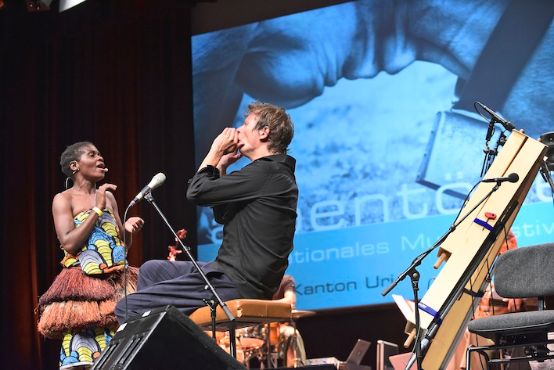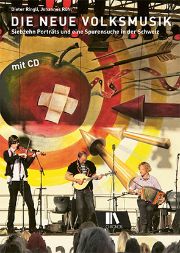On the trail of new folk music
A diverse music scene is explored in concise introductions and extensive interviews.

The director of the Alpentöne festival in Altdorf, Johannes Rühl, and Dieter Ringli, ethnomusicologist and lecturer at the Lucerne School of Music, have been observing new folk music in Switzerland for years, collecting press articles and recordings, supplementing this material with extensive interviews with musicians at home and now compiling it into a comprehensive non-fiction book.
In Switzerland, the term "new folk music" refers to instrumental and vocal music that experiments with traditional melodies, uses traditional instruments in new ways, mixes up yodeling with other vocal genres and reaches a largely urban audience in professional interpretations, especially at festivals, on cabaret stages and via Radio DRS2.
The phenomenon has been concentrated on the Alpentöne festival in Altdorf since 1999, the Naturtonfestival in Toggenburg since 2003 and the Stubete am See in Zurich since 2008, which may have prompted the authors to limit their investigation to German-speaking Switzerland. If one does not simply associate New Folk Music with the epochal edition of the ten thousand folk dances from all over Switzerland notated by Hanny Christen between 1940 and 1960, prepared for printing by Fabian Müller and Ueli Mooser and published in 2002 by the Gesellschaft für die Volksmusik in der Schweiz (GVS) as the initial spark, but considering the beginnings as a result of the fading folk movement in the 1980s and the experiments with old folk music on current occasions, the 700th anniversary of the Swiss Confederation (1991) and the World Expo in Seville (1992), initiators from French-speaking Switzerland should also be mentioned.
The expert authors present their examination of what is probably the most exciting music scene in Switzerland today in 13 short introductory chapters such as "News from back then", "Folk music intermediate worlds", "The Appenzell theme" and "The basis of folk". At the heart of the publication are 17 five-hour interviews with 13 male and 5 female musicians, transcribed and abridged by the editors, who also talk about their music on a CD.
Dieter Ringli's conclusion, which is well worth reading, states that it is impossible to reduce new folk music to a single denominator. This is confirmed by the informative biographies of Ueli Mooser, Markus Flückiger, Dani Häusler, Fabian Müller, Domenic and Madleina Janett, Thomas Aeschbacher, Nadja Räss, Töbi Tobler, Hans Kennel, Christoph Baumann, Dide Marfurt, Albin Brun, Christine Lauterbrug, Corin Curschellas, Erika Stucky, Christian Zehnder and Balthasar Streiff. However, most of these biographies begin with musically talented and understanding parents.
It is also noticeable that more than half of the contributors to this music trend are over sixty years old, well trained, have been influenced by traditional musicians and are hard-working. The desire to experiment with ever new line-ups, with the combination of different styles, with the interplay of ever different musical partners is the secret of the relaxed approach to traditional folk music.
The audio CD accompanying the book is supplemented by an informative, trilingual booklet published by the Musiques Suisses label, which has made it its mission to document New Folk Music. An introductory text, short biographies of the performers and 19 carefully selected sound samples provide a concentrated introduction to New Folk Music.
Dieter Ringli / Johannes Rühl, The New Folk Music. Seventeen portraits and a search for traces in Switzerland, 362 p., with CD, Fr. 38.00, Chronos-Verlag, Zurich 2015, ISBN 978-3-0340-1310-9
The new folk music. Musiques Suisses CD MGB -NV 30








